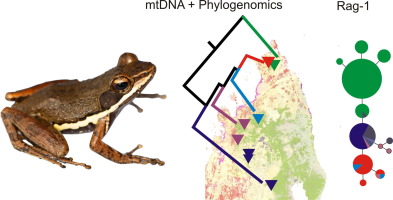当前位置:
X-MOL 学术
›
Mol. Phylogenet. Evol.
›
论文详情
Our official English website, www.x-mol.net, welcomes your
feedback! (Note: you will need to create a separate account there.)
Sympatric lineages in the Mantidactylus ambreensis complex of Malagasy frogs originated allopatrically rather than by in-situ speciation.
Molecular Phylogenetics and Evolution ( IF 3.6 ) Pub Date : 2019-12-03 , DOI: 10.1016/j.ympev.2019.106700 Safidy M Rasolonjatovo 1 , Mark D Scherz 2 , Carl R Hutter 3 , Frank Glaw 4 , Andolalao Rakotoarison 5 , Jary H Razafindraibe 6 , Steven M Goodman 7 , Achille P Raselimanana 1 , Miguel Vences 8
Molecular Phylogenetics and Evolution ( IF 3.6 ) Pub Date : 2019-12-03 , DOI: 10.1016/j.ympev.2019.106700 Safidy M Rasolonjatovo 1 , Mark D Scherz 2 , Carl R Hutter 3 , Frank Glaw 4 , Andolalao Rakotoarison 5 , Jary H Razafindraibe 6 , Steven M Goodman 7 , Achille P Raselimanana 1 , Miguel Vences 8
Affiliation

|
Madagascar's biota is characterized by a high degree of microendemism at different taxonomic levels, but how colonization and in-situ speciation contribute to the assembly of local species communities has rarely been studied on this island. Here we analyze the phylogenetic relationships of riparian frogs of the Mantidactylus ambreensis species complex, which is distributed in the north of Madagascar and was originally described from Montagne d'Ambre, an isolated mountain of volcanic origin, currently protected within Montagne d'Ambre National Park (MANP). Data from mitochondrial DNA, and phylogenomic data from FrogCap, a sequence capture method, independently confirm that this species complex is monophyletic within the subgenus Ochthomantis, and identify two main clades within it. These two clades are separated by 5.6-6.8% pairwise distance in the mitochondrial 16S rRNA gene and co-occur in MANP, with one distributed at high elevations (940-1375 m a.s.l.) and the other at lower elevations (535-1010 m a.s.l.), but show almost no haplotype sharing in the nuclear RAG1 gene. This occurrence in syntopy without admixture confirms them as independent evolutionary lineages that merit recognition as separate species, and we here refer to them as high-elevation (HE) and low-elevation (LE) lineage; they will warrant taxonomic assessment to confidently assign the name ambreensis to one or the other. Populations of the M. ambreensis complex from elsewhere in northern Madagascar all belong to the LE lineage, although they do occur over a larger elevational range than in Montagne d'Ambre (285-1040 m a.s.l.). Within LE there are several phylogroups (LE1-LE4) of moderately deep divergence (1.5-2.8% in 16S), but phylogroup LE4 that occurs in MANP has a deeply nested phylogenetic position, as recovered separately by mitochondrial and sequence capture datasets. This suggests that HE and LE did not diverge by a local fission of lower and upper populations, but instead arose through a more complex biogeographic scenario. The branching pattern of phylogroups LE1-LE4 shows a clear south-to-north phylogeographic pattern. We derive from these results a testable hypothesis of vicariant speciation that restricted the HE lineage to MANP and the LE candidate species to a climatic refugium further south, with subsequent northwards range expansion and secondary colonization of MANP by LE. These results provide an example for complex assembly of local microendemic amphibian faunas on Madagascar.
中文翻译:

马达加斯加青蛙的Mantidactylus ambreensis复合体中的同族谱系起源于异源地而不是原位形成。
马达加斯加的生物群系在不同的生物分类学水平上具有高度的微地方病特征,但在该岛上很少研究殖民化和原地物种形成如何促进当地物种群落的组装。在这里,我们分析了Mantidactylus ambreensis物种复合体的河岸蛙的系统发育关系,该复合体分布在马达加斯加北部,最初是从蒙塔涅·德安布雷(Montagne d'Ambre)进行描述的,该山脉是一座火山起源的孤立山脉,目前在蒙塔涅·丹比尔国家公园内受到保护(MANP)。来自线粒体DNA的数据和来自FrogCap的植物统计学数据(一种序列捕获方法)独立地确认该物种复合物在Ochthomantis属内是单系的,并确定了其中的两个主要进化枝。这两个分支之间的距离为5.6-6。线粒体16S rRNA基因的成对距离为8%,且在MANP中同时发生,其中一个分布在高海拔(940-1375 m asl),另一个分布在较低海拔(535-1010 m asl),但几乎没有单倍型共享在核RAG1基因中。在没有混合的同位态中的出现证实了它们是值得承认为独立物种的独立进化谱系,在这里我们将它们称为高海拔(HE)和低海拔(LE)谱系;他们将需要进行分类学评估,以自信地将ambreensis名称分配给其中一个。马达加斯加北部其他地方的安布雷斯分枝杆菌种群均属于LE谱系,尽管它们的海拔范围确实比蒙塔涅-德安布雷(285-1040 m asl)大。在LE内,有几个中等深度差异的植物群(LE1-LE4)(在16S中为1.5-2.8%),但MANP中出现的植物群LE4具有深层嵌套的系统发生位置,可通过线粒体和序列捕获数据集分别恢复。这表明HE和LE并没有因低和高人口的局部裂变而发生分歧,而是通过更为复杂的生物地理场景出现的。系统群LE1-LE4的分支模式显示出清晰的南北向系统地理模式。我们从这些结果中得出一个可以证明的物种进化假说,该假设将HE谱系限制于MANP,将LE候选物种限制在更南端的气候避难所,随后向北扩展范围,并由LE对MANP进行二次定居。
更新日期:2019-12-04
中文翻译:

马达加斯加青蛙的Mantidactylus ambreensis复合体中的同族谱系起源于异源地而不是原位形成。
马达加斯加的生物群系在不同的生物分类学水平上具有高度的微地方病特征,但在该岛上很少研究殖民化和原地物种形成如何促进当地物种群落的组装。在这里,我们分析了Mantidactylus ambreensis物种复合体的河岸蛙的系统发育关系,该复合体分布在马达加斯加北部,最初是从蒙塔涅·德安布雷(Montagne d'Ambre)进行描述的,该山脉是一座火山起源的孤立山脉,目前在蒙塔涅·丹比尔国家公园内受到保护(MANP)。来自线粒体DNA的数据和来自FrogCap的植物统计学数据(一种序列捕获方法)独立地确认该物种复合物在Ochthomantis属内是单系的,并确定了其中的两个主要进化枝。这两个分支之间的距离为5.6-6。线粒体16S rRNA基因的成对距离为8%,且在MANP中同时发生,其中一个分布在高海拔(940-1375 m asl),另一个分布在较低海拔(535-1010 m asl),但几乎没有单倍型共享在核RAG1基因中。在没有混合的同位态中的出现证实了它们是值得承认为独立物种的独立进化谱系,在这里我们将它们称为高海拔(HE)和低海拔(LE)谱系;他们将需要进行分类学评估,以自信地将ambreensis名称分配给其中一个。马达加斯加北部其他地方的安布雷斯分枝杆菌种群均属于LE谱系,尽管它们的海拔范围确实比蒙塔涅-德安布雷(285-1040 m asl)大。在LE内,有几个中等深度差异的植物群(LE1-LE4)(在16S中为1.5-2.8%),但MANP中出现的植物群LE4具有深层嵌套的系统发生位置,可通过线粒体和序列捕获数据集分别恢复。这表明HE和LE并没有因低和高人口的局部裂变而发生分歧,而是通过更为复杂的生物地理场景出现的。系统群LE1-LE4的分支模式显示出清晰的南北向系统地理模式。我们从这些结果中得出一个可以证明的物种进化假说,该假设将HE谱系限制于MANP,将LE候选物种限制在更南端的气候避难所,随后向北扩展范围,并由LE对MANP进行二次定居。











































 京公网安备 11010802027423号
京公网安备 11010802027423号